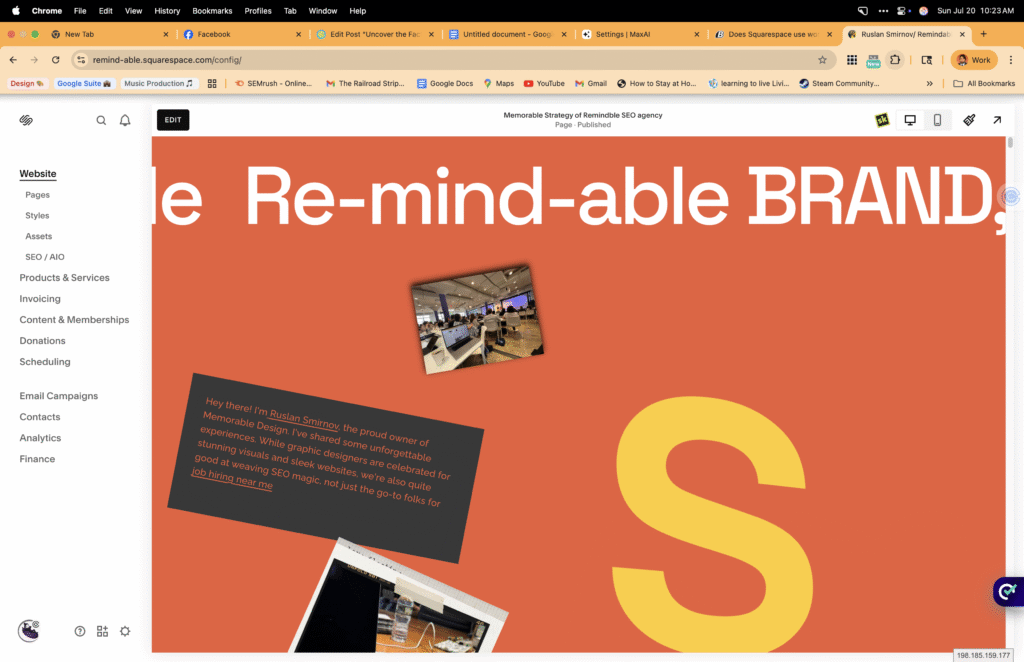Ever wondered about my adventure as a freelancer diving into the Squarespace portfolio world? Picture this: diving headfirst into SEO strategies for Roccoroma, where I partnered with built-in analytics tools to keep an eye on website traffic and the latest user buzz. I also embraced Google Analytics and Google Search Console for a more rounded view, threw in UTM codes for a fun twist on campaign tracking, and gathered client input through surveys to fine-tune our SEO strategies. And we can’t forget the amazing combo of Hotjar and Crazy Egg for analyzing user interactions—they transformed our approach into a comprehensive mission to conquer SEO hurdles on Squarespace! Showcasing my personal projects and experiences in the portfolio has made it more authentic and engaging, allowing potential clients to connect with my unique story.

An unforgettable portfolio management experience
Ever wonder how I got started with my consultant portfolio over at Memorable Design? It kicked off when I dived headfirst into designing websites using Squarespace! I’m still figuring out WordPress, but at Circle’s memorable events, I’m excited to showcase my art and designs. There, I highlight my projects with detailed case studies, complete with before-and-after visuals and a glimpse into my adventure of comparing website traffic 👍
On that platform, I warmly invite you to dive into my projects through engaging case studies. Each one showcases clear before-and-after visuals, artfully chronicling the journey and transformations of each design. I sprinkle in some intriguing insights about my approach and musings throughout the design process, especially when delving into website traffic analysis. By weaving my journey into blog stories, you’ll see how my designs bloom and make a real difference in driving site traffic and engaging users.

Upon diving into a portfolio consultant job description, I took the time to understand what this role entails. I carefully pondered the tasks and responsibilities, considering how they align with the overall position. This helped me gain a clear perspective on what it truly means to be a portfolio consultant.
Building My Consultant Portfolio SEO: Squarespace vs. WordPress

Ever wonder how brand challenges get tackled using SEO on Squarespace versus WordPress? Let me share a story about working with the Roccoroma brand.

Strategic Approaches in SEO: Squarespace vs. WordPress
In the realm of SEO, the choice between Squarespace and WordPress can significantly influence strategy and implementation. When collaborating with Roccoroma, I discovered that Squarespace’s integrated tools offered a streamlined process for beginners and those seeking an all-in-one platform. Its built-in SEO features, such as automatic sitemaps and clean URL structures, facilitated a straightforward enhancement of search visibility.
However, for those who prefer a more customizable experience, WordPress presents an opportunity to tailor SEO strategies more precisely. The plethora of plugins available, such as Yoast SEO, provides advanced options for keyword targeting, meta descriptions, and more. This flexibility can be particularly advantageous when addressing specific brand challenges or niche markets.
Working with Roccoroma allowed me to explore these platforms’ unique strengths. Squarespace‘s user-friendly interface was ideal for rapidly implementing changes and monitoring results. Meanwhile, WordPress required a more hands-on approach but rewarded us with granular control over the SEO elements.
Each platform serves its purpose, and the choice ultimately depends on the project scope, desired control level, and speed of implementation required. This experience underscored the importance of aligning the platform selection with the brand’s specific SEO goals and challenges. By leveraging the strengths of each platform, we can effectively drive traffic, enhance user engagement, and achieve sustained SEO success.
**Strategic Approaches in SEO: Squarespace vs. WordPress – Key Takeaways**
In the realm of SEO, the choice between Squarespace and WordPress can significantly influence strategy and implementation. When collaborating with Roccoroma, I discovered that Squarespace’s integrated tools offered a streamlined process for beginners and those seeking an all-in-one platform. Its built-in SEO features, such as automatic sitemaps and clean URL structures, facilitated a straightforward enhancement of search visibility. Our research into analytics and data played a crucial role in informing both SEO strategy and portfolio decisions, ensuring that each recommendation was evidence-based

However, for those who prefer a more customizable experience, WordPress presents an opportunity to tailor SEO strategies more precisely. The plethora of plugins available, such as Yoast SEO, provides advanced options for keyword targeting, meta descriptions, and more. This flexibility can be particularly advantageous when addressing specific brand challenges or niche markets.
Working with Roccoroma allowed me to explore these platforms’ unique strengths. Squarespace’s user-friendly interface was ideal for rapidly implementing changes and monitoring results. Meanwhile, WordPress required a more hands-on approach but rewarded us with granular control over the SEO elements. When organizing case studies, a focus on portfolio construction helped present SEO results in a way that highlighted diversification of strategies and outcomes
Each section of this analysis is designed to guide the reader logically through the comparison, improving clarity and user experience. Each platform serves its purpose, and the choice ultimately depends on the project scope, desired control level, and speed of implementation required. This experience underscored the importance of aligning the platform selection with the brand’s specific SEO goals and challenges. Before finalizing any SEO outcomes, it is essential to do a thorough check to ensure accuracy and compliance with best practices. By leveraging the strengths of each platform and working collaboratively with a dedicated team, we can effectively drive traffic, enhance user engagement, and achieve sustained SEO success.
Creating Engaging Content
The heart of any standout portfolio is engaging content that captures attention and tells a compelling story. Each case study should go beyond listing facts—use storytelling techniques to set the scene, explain the challenge, and walk the reader through your approach and the solution you delivered. Highlight key takeaways and outcomes, making it easy for potential clients to see the value you bring.
Incorporate visuals like images, infographics, or even short videos to add depth and make your portfolio more interactive and memorable. Use clear, concise language to ensure your content is easy to navigate and understand, while still providing enough detail to showcase your expertise. Don’t forget to include testimonials and real-world examples to reinforce your credibility. By focusing on clarity, depth, and storytelling, you’ll create a portfolio that not only informs but also inspires action.
Gathering and Using Testimonials
Testimonials are a powerful way to build credibility and trust with potential clients. They serve as social proof that you’ve delivered results and satisfied a range of clients across different industries. To gather impactful testimonials, ask for specific feedback from clients after completing a project—focus on the outcomes you delivered and the problems you helped solve.
When adding testimonials to your portfolio or website, make sure they’re detailed and include the client’s name, title, and company for authenticity. Place them strategically throughout your portfolio, such as alongside relevant case studies or on a dedicated testimonials page, to reinforce your expertise and the quality of your services. Showcasing a diverse range of testimonials demonstrates your ability to serve various clients and adds another layer of trust for anyone considering your consulting services.
Designing Your Portfolio
Designing your portfolio is about more than just aesthetics—it’s about creating an experience that guides potential clients through your work with clarity and focus. Start with a clean, modern layout that makes it easy to navigate. Use clear headings, concise language, and a logical structure to help visitors find the information they need quickly.
Enhance engagement by incorporating interactive elements like clickable links, embedded videos, or downloadable case studies. Make sure your portfolio highlights relevant examples, case studies, and testimonials that speak directly to your target audience’s needs. Don’t overlook the power of SEO—integrate relevant keywords and meta descriptions to improve your portfolio’s visibility and attract more potential clients online.
I open a company showcase for freelancers. Knowledge today, consulting today, is too expensive By investing time in thoughtful design and user experience, you not only improve how your work is perceived but also increase your chances of turning visitors into clients. A well-designed portfolio is a powerful tool for showcasing your expertise, building trust, and opening the door to new business opportunities.








